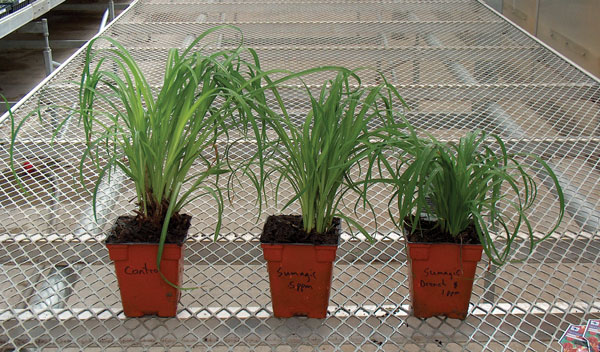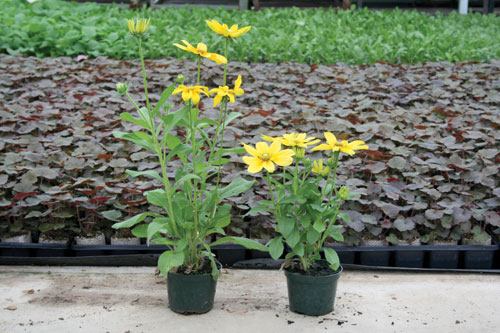4/1/2020
Paul’s PGR Primer
Paul Pilon

Using plant growth regulators (PGRs) on perennials is one of the most common topics growers ask me questions about each spring. With spring in full swing, I thought I’d share some guidelines to help improve your success using these height-management tools.
Before we get to the guidelines, I’d like to go over the reasons to apply PGRs and the benefits they provide when PGRs are used effectively.
• Decreases plant size—both height and width
• Allows plants to be grown at high plant densities while maintaining quality
• Reduces the need for maintenance activities, such as spacing or trimming
• Improves shipping efficiencies—more plants per rack
• Increases shelf life at retail and holding ability at the production facilities
Paul’s PGR Picks
There are numerous PGRs available for growers to use on perennials. Although many of them are effective at controlling height on some perennials, the products or PGR combinations in Table 1 are some of my favorite choices for controlling plant height of perennials.
Depending on the plant, there are often other PGR options, but I use the products in the table on the vast majority of the perennials requiring height control. Of these, the daminozide + uniconazole combination is my absolute favorite. These rates are the starting rates for perennials with average growth habits. Apply half the spring rates when making applications to perennials that are sensitive to PGRs. Use the summer rates when making spring applications to perennials with aggressive growth habits.
 The rates in the table are most applicable to growers in the northern half of the United States. Although, southern application rates in the spring may start off the same as the northern rates, it’s usually necessary to use higher application rates in the South (up to twice the rates used in the North). If you’re growing perennials in the South, consider using the northern summer rates as the southern spring rates and increase them as the season
The rates in the table are most applicable to growers in the northern half of the United States. Although, southern application rates in the spring may start off the same as the northern rates, it’s usually necessary to use higher application rates in the South (up to twice the rates used in the North). If you’re growing perennials in the South, consider using the northern summer rates as the southern spring rates and increase them as the season
progresses.
Where are PGRs absorbed?
PGRs containing daminozide are only absorbed through plant leaves and it takes them a long time to get into the plant. For this reason, don’t apply PGRs containing daminozide with drench applications. It’s also very important to apply them when the leaves can remain wet for several hours following the application. Apply daminozide while low evaporation conditions are present (early mornings, late evenings and during cloudy conditions) and never overhead irrigate the plants after the application.
Spray applications with PGRs containing paclobutrazol and uniconazole are absorbed through the stems. Therefore, it’s critical to ensure the spray solution uniformly covers the stems and not just the leaves of the plants. Several growers don’t obtain the efficacy of these PGRs due to inadequate coverage on the plant’s stems. These active ingredients are also absorbed by the roots and are great for making drench applications.
Spray application timing
PGRs work by controlling cell elongation before it occurs and has the greatest effect on young, actively growing plant tissues. Therefore, the best results are achieved when PGRs are used throughout the growing cycle to “regulate” plant development, rather than at the end of the crop. This approach requires multiple applications (typically two or three) during the production cycle.
Unfortunately, there’s not a one-size-fits-all strategy to determine when PGRs should be applied. There are numerous factors to consider when determining the need for plant growth regulators. Growers will need to observe the current growth rate and anticipate how much growth is likely to occur in the short term. Every crop should be evaluated independently each week.
 A rule of thumb I follow when plants are grown in pot-to-pot configurations is to make the initial application before the leaves reach the edge of the containers they’re being grown in. Most crops will require a second application when the leaves are just beginning to touch; typically seven to 10 days following the first application. The plants should be evaluated seven days following the second application to determine the need for a third application. At this time, the leaves from adjacent plants are beginning to overlap slightly, but haven’t formed a dense canopy.
A rule of thumb I follow when plants are grown in pot-to-pot configurations is to make the initial application before the leaves reach the edge of the containers they’re being grown in. Most crops will require a second application when the leaves are just beginning to touch; typically seven to 10 days following the first application. The plants should be evaluated seven days following the second application to determine the need for a third application. At this time, the leaves from adjacent plants are beginning to overlap slightly, but haven’t formed a dense canopy.
Not only does splitting the applications up in this manner better “regulate” the growth during production, it allows for good coverage of the PGR solution on the stems. This is essential when using paclobutrazol or uniconazole. Multiple applications also allow growers the flexibility of determining if additional applications are necessary and if rate adjustments are necessary.
The importance of spray volume
Here’s the most important take-home message I can offer: The volume of spray solution applied over an area has a greater effect on the results than the concentration of the solution does. For spray applications, every PGR label recommends spray applications be made using two quarts of spray solution per 100 square feet. When less spray volume is applied, poor coverage and an unsatisfactory level of height reduction often results. Conversely, if more spray volume is applied, over-growth regulation is likely. Proper coverage using the appropriate spray volume is the most important aspect of using PGRs successfully.
If you like what you’ve read here and want to further increase your knowledge about using PGRs on perennials, check out the 2020 GrowerTalks Perennial PGR Guide sponsored by Fine Americas. GT
Paul Pilon is a Perennial Production Consultant and editor-at-large of the Perennial Pulse e-newsletter. Feel free to contact him with article topics or to address your perennial production challenges. He can be reached at paul@perennialsolutions.com.